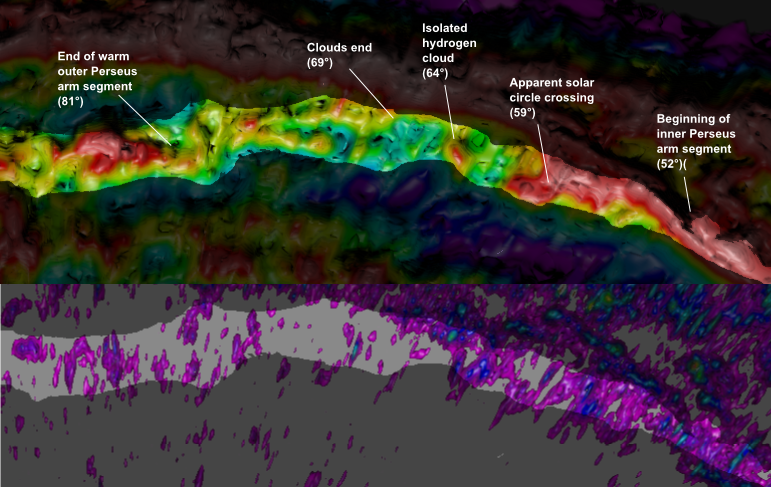Zhang, Reid, et.al. 2013 contributed two more accurate radio parallax distance measurements for star formation regions in the Perseus arm and then made the very interesting comment:
We have found almost no H2O maser sources in the Perseus arm for 50° < l < 80°, suggesting that this ≈6 kpc section of the arm has little massive star formation activity.
This attracted my attention because as you can see from the image below, there are also gaps in atomic hydrogen and molecular clouds in this direction:

This image is taken from the Velocity Explorer, which represents velocity data from atomic and molecular surveys in polar coordinates.
The highlighted part at the top shows the atomic hydrogen velocity associated with the Perseus arm in this direction. The part at the bottom shows the same data for molecular clouds.
As you can see, there are similar results for both atomic and molecular data and they show a major gap between the warm clouds associated with the Perseus arm in the outer galaxy and the warm clouds associated with the Perseus arm in the inner galaxy. Within this gap there is one isolated warm cloud and a bit of emission associated with the direction in which the Perseus arm appears to cross the solar circle.
We should keep in mind that velocity data near the solar circle may be associated with the local movement of hydrogen clouds near the sun rather than galactic rotation, so the solar crossing emission shown above may not be associated with the Perseus arm.
The wide gap in star formation regions, atomic hydrogen and molecular clouds raises the question of whether the inner and outer Perseus arms are perhaps separate structures.
This question becomes even more interesting when we consider the Cygnet spur, a bridge between the Norma and Perseus arms in the outer galaxy described here. Instead of considering the Cygnet velocity structure as a spur, it may actually reveal that the outer Perseus arm branches off the Norma arm.
I show the two distinct parts of the Perseus arm in the face-on image I described in my previous blog post.
